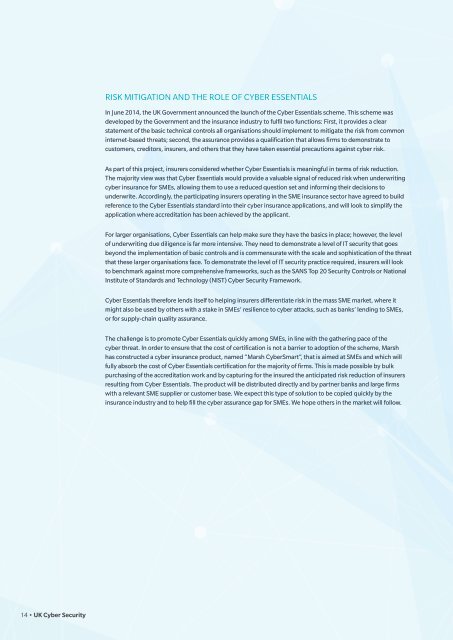RISK MITIGATION AND THE ROLE OF CYBER ESSENTIALSIn June 2014, the UK Government announced the launch of the Cyber Essentials scheme. This scheme wasdeveloped by the Government and the insurance industry to fulfil two functions: First, it provides a clearstatement of the basic technical controls all organisations should implement to mitigate the risk from commoninternet-based threats; second, the assurance provides a qualification that allows firms to demonstrate tocustomers, creditors, insurers, and others that they have taken essential precautions against cyber risk.As part of this project, insurers considered whether Cyber Essentials is meaningful in terms of risk reduction.The majority view was that Cyber Essentials would provide a valuable signal of reduced risk when underwritingcyber insurance for SMEs, allowing them to use a reduced question set and informing their decisions tounderwrite. Accordingly, the participating insurers operating in the SME insurance sector have agreed to buildreference to the Cyber Essentials standard into their cyber insurance applications, and will look to simplify theapplication where accreditation has been achieved by the applicant.For larger organisations, Cyber Essentials can help make sure they have the basics in place; however, the levelof underwriting due diligence is far more intensive. They need to demonstrate a level of IT security that goesbeyond the implementation of basic controls and is commensurate with the scale and sophistication of the threatthat these larger organisations face. To demonstrate the level of IT security practice required, insurers will lookto benchmark against more comprehensive frameworks, such as the SANS Top 20 Security Controls or NationalInstitute of Standards and Technology (NIST) Cyber Security Framework.Cyber Essentials therefore lends itself to helping insurers differentiate risk in the mass SME market, where itmight also be used by others with a stake in SMEs’ resilience to cyber attacks, such as banks’ lending to SMEs,or for supply-chain quality assurance.The challenge is to promote Cyber Essentials quickly among SMEs, in line with the gathering pace of thecyber threat. In order to ensure that the cost of certification is not a barrier to adoption of the scheme, Marshhas constructed a cyber insurance product, named “Marsh CyberSmart”, that is aimed at SMEs and which willfully absorb the cost of Cyber Essentials certification for the majority of firms. This is made possible by bulkpurchasing of the accreditation work and by capturing for the insured the anticipated risk reduction of insurersresulting from Cyber Essentials. The product will be distributed directly and by partner banks and large firmswith a relevant SME supplier or customer base. We expect this type of solution to be copied quickly by theinsurance industry and to help fill the cyber assurance gap for SMEs. We hope others in the market will follow.14 • UK Cyber Security
RISK GOVERNANCE AND RISK QUANTIFICATIONCyber attacks have the potential to be crisis events given the scale of damage, speed of impact, and reputationaldamage that can follow. This can lead to a negative cycle of declining investor and customer confidence thatsqueezes cash availability and leads to a liquidity crisis akin to a run on a bank.For some firms this is not a new situation, with financial institutions, utilities, and other critical infrastructurefirms used to having to manage “tail risk” of this form. Most companies’ typical risks involve low-level impactsthat can be managed within the business, monitored via a risk register, and mitigated by insurance.That approach is likely to be inadequate for a tail risk like cyber, however, given the scale and pace with which itcan threaten business viability. This becomes a reporting issue for listed firms under the viability statement nowrequired by the UK Corporate Governance Code. More generally, it becomes a challenge for how riskgovernance operates.There are several aspects of risk governance adopted by critical infrastructure providers that offer greaterprotection against cyber and other tail risks, and which are useful pointers for firms less used to dealing withthese kind of risks. We highlight three in particular:If an eventhappens, thefirm needs tohave consideredits sourcesof cash, itsmessage tostakeholders,alternativesupply routes,and many otherconsiderationsthat go wellbeyond the ITattack point.••A board risk committee, chief risk officer, and risk function that all operate independently ofexecutive management.••A recovery plan that brings together financial, operational, reputational, and other critical functions undera single structure.••The use of risk scenarios and stress-testing of financial resilience against these.The ownership of risk and recovery planning is particularly relevant for cyber risk. Many firms houseresponsibility for cyber in technical or security teams. These have a lot to contribute to making the firm safe,but the risk and response plan needs oversight across functions. If an event happens, the firm needs tohave considered its sources of cash, its message to stakeholders, alternative supply routes, and many otherconsiderations that go well beyond the IT attack point. For example, some firms have adopted “operational ringfencing”to ensure that certain assets can be disposed of readily in the event of a crisis occurring (noting thatsuch an approach may reduce the synergies of common ownership).In terms of stress-testing, the challenge is how to select scenarios and quantify their impact. We have earlierprovided a taxonomy of cyber risk as a basis for flushing out scenarios a firm should consider (see Figure 1),noting that these will be different in type and potential severity for each firm. This makes it likely that there willbe more than one form of business-critical cyber event to consider. To quantify losses, the traditional approach isto look at historic loss data as a basis for estimating the probability of an event exceeding a given size. However,such a “value at risk” measure is very difficult with a new risk such as cyber because data is so limited. It alsofocuses on an absolute loss, which may be relevant to the long-run capital position of the firm, but much less soto surviving a cash crisis.The Role of Insurance in Managing and Mitigating the Risk • 15


